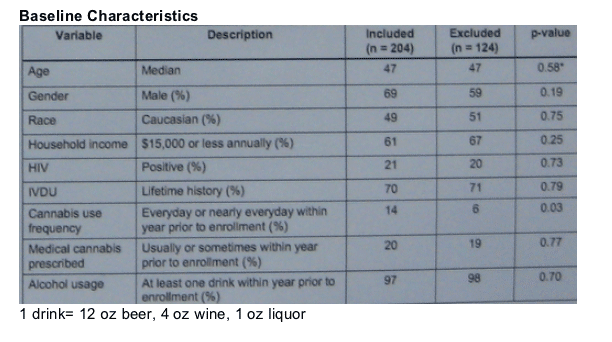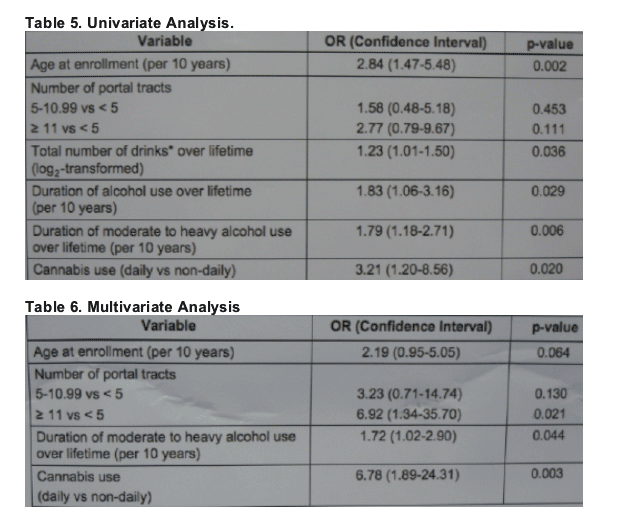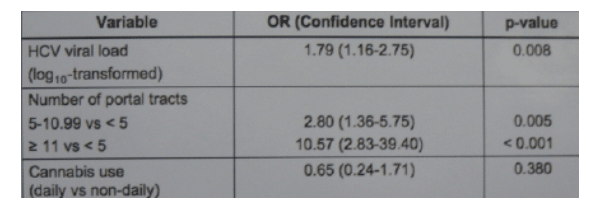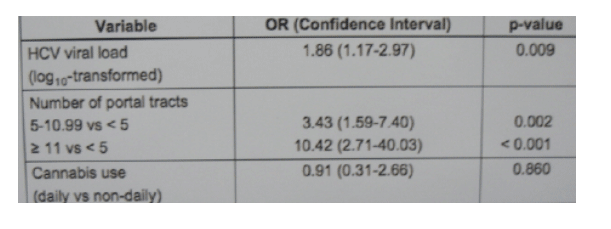 |
 |
 |
| |
Daily Cannabis Use by HCV+ Increased Odds of Moderate to Severe Fibrosis by 7- Fold
|
| |
| |
Reported by Jules Levin
57th Annual Liver Meeting (AASLD, American Association for the Study of Liver Diseases)
Oct 27-31, 2006
Boston, MA
"Influence of Cannabis Use on Severity of Hepatitis C Disease"
Authors Conclude: "Current daily cannabis use was strongly associated with moderate to severe fibrosis in persons with chronic HCV infection. Our results indicate that HCV-infected individuals should be counseled to reduce or abstain from cannabis use."
J. H. Ishida1; C. Jin2; P. Bacchetti2; V. Tan3; M. G. Peters1; N. A. Terrault1
1. Medicine, University of California, San Francisco, San Francisco , CA, USA.
2. Epidemiology and Biostatistics, University of California, San Francisco, San Francisco , CA, USA.
3. Pathology, University of California, San Francisco, San Francisco , CA, USA.
Complications of hepatitis C virus (HCV) infection are primarily related to the development of advanced fibrosis. Previously identified risk factors for fibrosis include male gender, older age at HCV infection and heavy alcohol use, but the role of cannabis remains controversial. Cannabis use is prevalent & mouse models indicate a biological basis for a potential effect of cannabis on liver fibrosis.
STUDY OBJECTIVES
1. This study objective was to assess the frequency of cannabis use in persons with chronic HCV infection.
2. To determine the association of cannabis use with liver fibrosis severity.
3. To determine whether the association of cannabis use differs by the stage of fibrosis.
AUTHOR CONCLUSIONS
Current daily cannabis use independently increased the odds of moderate to severe fibrosis by nearly 7-fold in persons with chronic HCV infection.
--The duration of lifetime moderate to heavy alcohol use was also an independent predictor of moderate to severe fibrosis.
There was no association between current daily cannabis use and mild fibrosis.
--HCV viral load was an independent predictor of mild fibrosis.
The number of portal tracts was associated with both mild & moderate to severe fibrosis, highlighting the importance of controlling for biopsy adequacy.
Limitations
--The cross-sectional design limits the ability to establish a temporal relationship between cannabis use & fibrosis stage.
--Quantity, duration or method of cannabis use were not assessed in detail.
Future Directions
--Confirm differential effect of cannabis use by severity of disease
--Prospective cohort study of cannabis versus non-cannibas users with chronic HCV infection using more detailed assessments.
Methods:
This is a cross-sectional study. Between 2001 and 2004, 204 HCV-infected subjects enrolled from university and community sources underwent in-person interviews (to assess demographics, risk factors for HCV, and use of cannabis and alcohol), virologic testing and liver biopsy. Biopsies were scored for fibrosis using the Ishak method (scale F0 to F6) by a single pathologist blinded to clinical data. Biopsy adequacy was assessed by length and number of portal tracts.
Results:
Of the 328 subjects enrolled, 204 completed all thebaseline visit requirements, including liver biopsy, and formed the study cohort. Included and excluded subjects were not significantly different except that the former group used cannabis more frequently than the latter group.
The median age of the cohort was 47 years, 69% were male, 49.0% were Caucasian, 61% earned ≦$15,000 per year, 21% were HIV+. 70% had a lifetime history of IVDU (the presumed route of infection was intravenous drug use).

The median lifetime duration and average daily use of alcohol were 29.1 years and 1.94 drink equivalents per day.
Current (within 12 months of enrollment) cannabis use frequency was daily in 13.7%, occasional in 45.1% and never in 41.2%.
Fibrosis stage was F0, F1-2 and F3-6 in 28%, 55% and 15% of subjects, respectively.
The majority of the study cohort participants had stage 0-2 fibrosis and mild inflammation. The median AST & ALT levels were less than 1.2 times the upper limit of normal.
Daily (compared to non-daily or no) cannabis use was strongly associated with moderate to severe fibrosis (F3-6) compared to mild fibrosis (F1-2) in univariate [OR = 3.21 (1.20-8.56), p = 0.020] and multivariate analyses [OR = 6.78 (1.89-24.3), p = 0.003]. But, cannabis was not associated with mild fibrosis in univariate or multivariate analysis. In other words, this study found that patients with moderate to severe fibrosis were 3.21 times more likely to be smoking pot daily compared to individuals who smoked on a non-daily bases; also, for patients who only had mild fibrosis smoking pot daily was not associated. (see tables below).
Predictors of Moderate to Severe Fibrosis (F3-6)

Other independent predictors of moderate to severe fibrosis were lifetime duration of moderate to heavy alcohol use (≥2 and ≥4 drinks per day in women and men, respectively) [OR = 1.72 per 10 years (1.02-2.90), p = 0.044] and ≥11 portal tracts (compared to <5) [OR = 6.92 (1.34-35.7), p = 0.021]. Age was of borderline significance [OR = 2.19 per 10 years (0.95-5.05), p = 0.064].
Predictors of Mild Fibrosis
Daily cannabis use did not appear to be strongly associated with mild fibrosis (F1-2) compared to no fibrosis (F0) in univariate or multivariate analysis. Independent predictors of mild fibrosis were HCV viral load [OR = 1.86 per log10 increase (1.17-2.97), p = 0.009], 5 - <11 portal tracts (compared to <5) [OR = 3.43 (1.59-7.40), p = 0.002] and ≥11 portal tracts (compared to <5) [OR = 10.4 (2.71-40.0), p <0.001].
Table 3. Univariate Analysis
Gender, race, enrollment age, HCV duration and infection source, HCV genotype, HIV, BMI, daily tobacco use, and lifetime alcohol use were not significantly associated with mild fbrosis stage in univariate analysis.

Table 4, Multivariate Analysis
Gender, race, enrollment age, HCV infection duration & source, HCV genotype, HIV, BMI, daily tobacco use, and lifetime alcohol use were not significantly associated with mild fibrosis stage in multivariate analysis.

|
| |
|
 |
 |
|
|